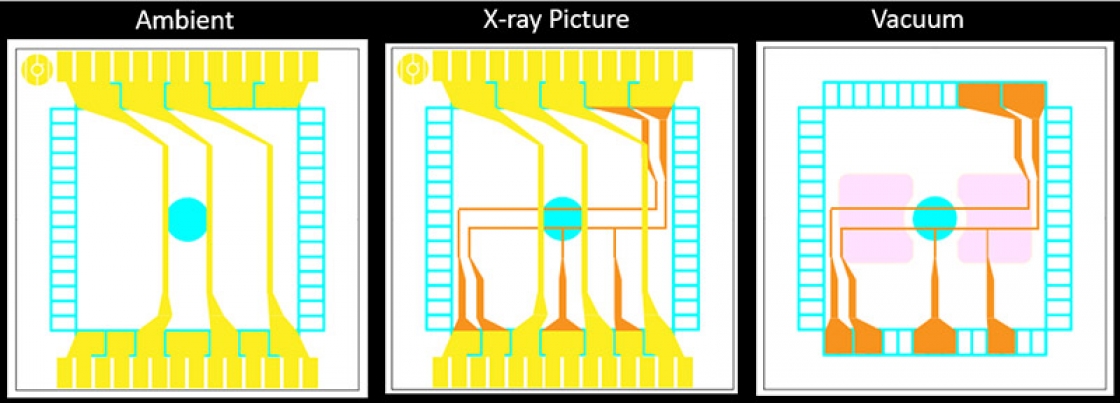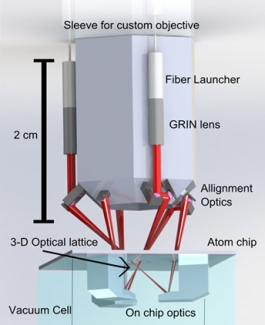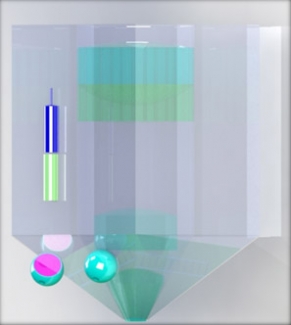Cold Atom Laboratory

The Cold Atom Laboratory (CAL) is being designed to enable earth-bound researchers to carry out ultracold atom physics experiments in the micro-gravity environment of the International Space Station (ISS). Earth-bound experiments are subject to acceleration due to the Earth's gravity, and the corresponding energy shifts can be large compared with the temperature and quantum mechanical energy of ultracold atoms. Setting gravity to nearly zero allows one to carry out experiments and observations not possible with table-top experiments on Earth.
The Anderson group is collaborating with the NASA Jet Propulsion Laboratory and ColdQuanta Inc. to design an atom chip for the CAL mission (link to http://coldatomlab.jpl.nasa.gov/). The atom chip, designed by the Anderson group and pictured in Figure 1, will enable a large number of NASA sponsored experiments to be carried out in the microgravity environment of the International Space Station. These experiments were selected by a nationwide competition in which the world’s best principal investigators all submitted proposals for groundbreaking experiments that this facility will enable. Proposals selected (released by JPL January 2014) include:
- Jason Williams, Jet Propulsion Laboratory, "Fundamental Interactions for Atom Interferometry with Ultracold Quantum Gases in a Microgravity Environment"
- Eric Cornell, University of Colorado, Boulder, "Zero-G Studies of Few-Body and Many-Body Physics"
- Nathan Lundblad, Bates College, "Microgravity dynamics of bubble-geometry Bose-Einstein condensates"
- Georg Raithel, University of Michigan, Ann Arbor, "High-precision microwave spectroscopy of long-lived circular-state Rydberg atoms in microgravity"
- Nicholas Bigelow, University of Rochester, "Consortium for Ultracold Atoms in Space"
The proposals, while proprietary, contain exciting new experiments, which will be enabled by the Anderson group’s custom designed atom chip. The capabilities of the atom chip include:
- Two on-chip BEC formation locations (directly underneath the center window, and directly underneath the mirror region)
- Loading from MOT transfer coils
- Deep trap required to capture maximum number of atoms
- Evaporation trap (BEC formation)
- Very high trap frequencies, ~2kHz in y,z and ~100Hz in x directions
- Through-Chip Imaging
- Trap location at 500 microns below chip, centered in x,y coordinates
- Delta Kick Cooling
- Spherical Trap
- 3:1 aspect ratio at a distance of ~1mm from chip (can be released and imaged after free expansion with low res imaging camera)
- Preparation for atom interferometry in side chip location, including evaporation, delta kick cooling, and atom location placement for in-vacu optics
This chip is currently in the fabrication stages and will be deployed to the international space station with the first CAL mission in April 2016.
Current Work
To prepare for future missions, our group is now working on the development of a CAL 2 testbed with capabilities for an on-chip 3D optical lattice combined with in-situ imaging system. The concept work for this experiment is pictured in Figure 2. The red-detuned lattice beams will operate at 852 nm, sufficiently red detuned to trap and hold Rubidium atoms in order to study their dynamics using the in-situ imaging system built underneath the lattice launching optics. Recent implementation of this concept is pictured in Figure 3, where lenses for the 0.4 NA in-situ imaging objective have been selected and miniature optics for positioning of lattice beams have been designed.
The atom chip for this experiment, while building upon the previous work of our group’s compact atom chip systems, will feature a unique metallization pattern, designed to enable excellent optical access for the 3D lattice that will sit directly beneath the chip.
This experiment, when built, will have exciting capabilities for physics never before seen in conjunction with an atom chip, with applications to quantum information science, metrology, and other fields relevant to atom optics. Its earth-bound development by the Anderson group will ensure the possibility of an optical lattice system to be incorporated into a future CAL 2 mission.






